Laser Eye Protection: Protecting Your Eyes from the Emerging Domestic Laser Threat.
As if cops in the U.S. don’t have enough to worry about, 2020 came along and added laser beams to the mix. We’ve seen protesters in Portland wielding handheld lasers against police officers during nightly street clashes. The social unrest surrounding George Floyd’s death has led to more than 130 consecutive days of violent protests in Portland, with other high-intensity, shorter duration demonstrations popping off in cities around the country.
Lasers will only become more popular among street protestors, so it’s worth a few minutes to learn how they work and how to protect yourself from them.
BOUND TO HAPPEN HERE
While lasers are a new threat to American LEOs, the first notable use of handheld lasers in civil unrest was overseas in 2013. Demonstrators packed Cairo’s Tahrir Square calling for Egyptian President Mohamed Morsi to step down. The crowd focused their cat toys on an Egyptian military helicopter flying over the demonstration, menacing the protestors. Images of the laser-painted helo transmitted from the scene were eye-catching, and the media coverage helped focus the world’s attention on Egyptian politics.
Later, in 2019, sophisticated protesters in Hong Kong used cheap, handheld lasers to fry the CCDs in surveillance equipment used by the state to collect evidence against agitators during anti-Chinese government protests.
Taking it a third step, South American protestors watching the Hong Kong protests realized shining $30 novelty lasers directly at riot control officers were effective tools to distract, disorient, and possibly injure them during street protests.
This brings us to America in 2020, where all three of these tactics melded into the threat facing law enforcement officers working protest details in Portland, Seattle, and other areas of unrest around the country.
BUT AREN’T LASERS EXPENSIVE?
While a harmless laser pointer can be had for a few bucks at a gas station, one might expect a much more potent laser to be prohibitively expensive, thereby keeping them out of the hands of broke-ass, troublemakers.
Well, yeah … decades ago these devices were exotic and pricey, but the laser’s industrial ubiquity made its components and methods of manufacturing dirt cheap. The expense of a modern laser isn’t based on how much power it puts out, but in the refinement of its performance.
“It’s harder and more expensive to make a laser that’s actually 5mW and complies with safety regulations,” says Garth Blocher, a research engineer with Revision Military.
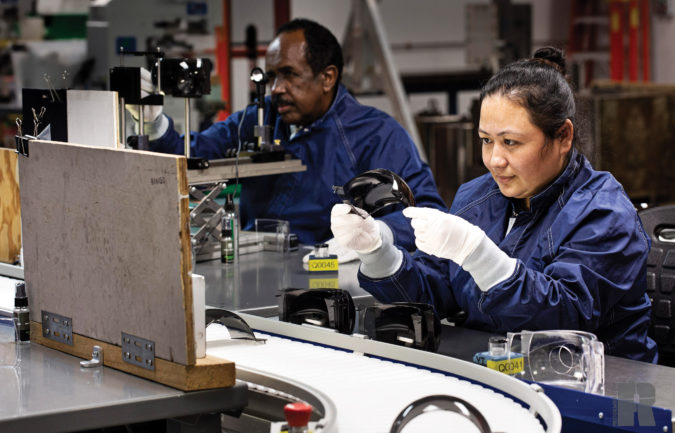
Revision Military’s Muna Majhi and Ali Adam inspect lens blanks that’ll later be cut into lenses for StingerHawk eyewear. Revision manufactures its lenses entirely in Vermont and inspects each lens by hand before shipping them to customers.
He cites Revision’s recent in-house testing of a dozen handheld lasers the company bought from various online vendors. His testing mirrors concerns laid out in a 2013 U.S. National Institute of Standards and Technology report that says in a test of 122 commercial laser pointers, 89.7 percent of the green lasers put out more power than they were supposed to. Of that, 52 percent put out more than double their rated power.
Technological advances along with economies of scale have made lasers dirt cheap. So, making a dangerously powerful laser costs less than making an eye-safe emitter because the safety engineering and components raise the price and eat into the profit margins of the lower-powered laser made by gray market importers.
HIGH END VS. LOW END
An infrared military target designation laser costs tens of thousands of dollars — not because it’s powerful, but because it’s far more complex than any commercial laser pointer. It’s made to pulse its output at sub-microsecond intervals, encoding the laser beam with targeting information that’s read by laser sensors on airborne sensor pods or falling munitions in real time. This requires a laser capable of exquisitely controlled output that works in a range of environments, from hot desert runways to the cold skies over a war zone — and that’s not cheap.
On the other hand, handheld lasers are relatively simple devices. While the enclosures might look snappy on higher-end products, the guts are a commodity made as inexpensively as possible. Think of it this way, if a military laser is a Mercedes-Benz E-Class, a novelty, handheld laser is as refined and safe as your cousin’s lawn mower-powered go-cart. Despite the Federal Food and Drug Administration’s oversight of novelty laser manufacturers and importers, compliance seems like it’s achieved with a simple warning sticker.
WHAT’S A LASER?
In order to appreciate the threat posed by lasers, let’s take a step back and geek out a little. Lasers emit a beam of light with three features that distinguish it from common, diffused light sources. The light from a laser is coherent, monochromatic, and collimated.
Coherent means the waves of radiation that form the light are packed together and traveling in the same direction and at the same speed. Monochromatic means the light emitted from the laser is all the same color or wavelength, expressed in nanometers. And collimated light is a beam that spreads out very little as it gets further from its source. This is expressed as a beam’s divergence, measured in minutes of angle (or milliradians).
In layman’s terms, a laser to the face results in wincing and looking away, and you might end up with sunspots or permanent eye injury if you force yourself to look at it. It’s tough to know the intent of the people wielding the laser, but it’s likely they’re either trying to blind you or make you look away so you can’t see them lighting fireworks or gearing up to toss projectiles your way.
CLASSIFICATIONS
A laser’s output is measured in milliwatts (mW), and lasers are broken up into a number of classes by the FDA based on the threat they pose.
Class I lasers put out less than 0.5 mW and are harmless. Class II lasers operate at up to 1 mW and pose little threat to eyesight since the eye’s blink response significantly reduces the chance of injury, but they can cause eye injury inside of about 23 feet if you stare into them. Class IIIa (also called Class 3R) lasers are 1 to 5 mW and are barely more dangerous than Class II lasers but can hurt eyes inside of about 52 feet.
Things get sporty at Class IIIb (also called Class 3B). These handheld lasers in the 5 to 500mW range can cause damage to eyesight with extended exposure (roughly more than a half-second) inside 520 feet. Class IV lasers aren’t generally handheld, so it’s rare to see one in a protest. However, they put out more than 500 mW and burn exposed skin, cause instant damage to eyesight, and present an eye injury hazard from as far away as 733 feet.
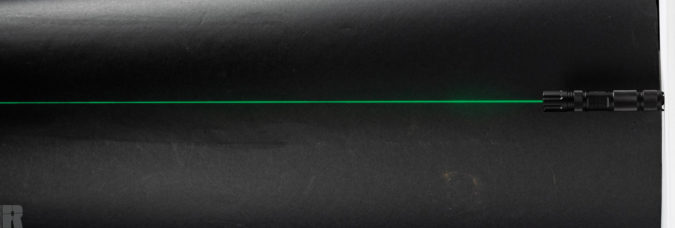
PRACTICAL INFO
Lasers come in a range of colors, but we’ll focus on three in particular: red, green, and infrared (IR). Red is the cheapest and was once the most common, green is now the most popular color laser as well as the brightest, and IR is the most dangerous.
RED LASERS
Generally, red lasers (650 nm) aren’t particularly harmful to eyesight because most red laser pointers are best suited as cat toys — though they do present a threat to situational awareness. Like all visible lasers, the threat escalates from distraction, as lasers are hard to ignore and cause disorientation. It’s hard to keep your eyes open with a bright laser shining in your face, and eventually injury may result from either the laser burning the eye, or from a brick or something thrown by the protestors while you’re forced to look away.
INFRARED LASERS
IR lasers (700+ nm) are particularly dangerous because they’re invisible. You might wonder how invisible light is dangerous. Think of the sun and a sunburn. You can’t really “see” sunlight, but you know a big dose of it will burn the hell out of you — same thing with IR lasers and your eyes. You can’t see the light, but you’ll eventually feel it if you look into its source long enough. If you can’t see it, your eye’s natural defense, the blink response, won’t protect you. IR lasers are found in laser range finders and all sorts of military targeting laser systems, because they’re invisible to the naked eye.
GREEN LASERS
Green lasers (532 nm) are the greatest combined threat to officers’ eyes. First, green lasers appear the brightest because human eyes are most sensitive to green light. Second, many green lasers are contaminated with dangerous IR light.
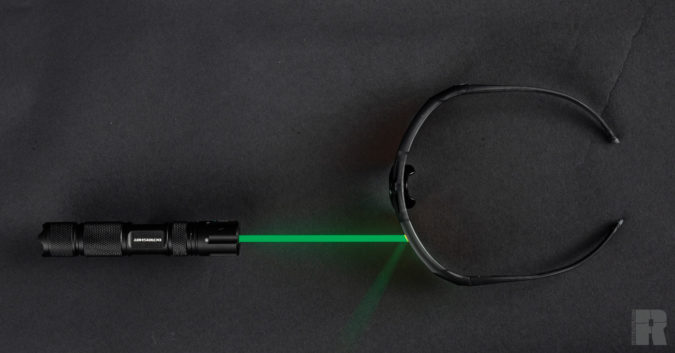
A green laser pointed at the Revision Stingerhawk with an FT2 lens is stopped cold. Look closely; while most of the laser’s energy is absorbed by the lens dyes, some is reflected away.
IR CONTAMINATION
Most lasers made in the last couple years use new technology that eliminates the threat of IR contamination. According to Mark Cameron, a systems engineer with B.E. Meyers, green lasers made up until around 2017 used DPSS technology, short for diode-pumped solid-state.
At a time when lasers were either IR or red, DPSS was 1990s witchcraft that turned IR lasers into green lasers using math and a couple of crystals. The problem with DPSS lasers, as noted earlier, is that they emit IR along with the green light. Properly made DPSS lasers have filters in their output stage to neutralize this IR contamination. But novelty lasers are bootleg AF, and any bootlegger worth his eye patch will tell you deciding between cheap and safe is hardly a decision at all.
Isn’t the U.S. FDA and its laser classification and regulation system supposed to protect us from this sort of thing? Yes. But it seems the department applies the same effort to laser testing as it does to mattress tag inspections.
Luckily, sort of, direct drive diode laser emitters hit the market a few years ago. They’re cheaper than DPSS emitters and don’t put out any IR. There are still plenty of legacy DPSS lasers on the street, but chances are good that most lasers bought recently are direct drive green lasers without the threat of an IR-contaminated beam.
LASER DEFENSE
Laser lenses work by putting a wavelength-absorbing dye between the laser and your eye. Most are made for use in laboratories, and the dyes are in a coating applied to the face of the lens. For the street, you’ll want something far more durable. And for that, tactical eyepro makers worth their salt mix the magic dye directly into the lens material, so it’s baked in and can’t be scratched off. You also want to make sure you get a ballistic lens that’s rated for the kind of projectiles your friends in black will be offering up from their side of the protest line.
Assuming you’re looking at a ballistic lens with impregnated dyes, there are three key considerations for LE folks looking for laser eye protection. First is determining the color of the laser you want protection against, then looking at the amount of light in a given wavelength the lens blocks, and lastly looking at how much visible light you’ll have to give up for that protection.
|
Laser Colors |
|
Violet: 405 nm |
|
Blue: 445 nm |
|
Green: 532 nm |
|
Ruby: 694.3 nm |
|
Near IR: 800-900 nm, 1,064 nm |
The blocked color is defined by the wavelength (or range of wavelengths) the dyes in a lens blocks. The amount of light a lens blocks is known as its optical density (OD) and is provided for a specific wavelength. It’s specified as a number from 0 to 7, with 7 offering the most protection. The perceived amount of light the lens allows to pass is the visible light transmission (VLT). These three specs are the key to choosing the most appropriate lens for your tactical situation. The more wavelengths you want to block, the less colors you’ll be able to see. If you want more protection from each of those colors, you’ll have to accept a darker lens.
NO, YOU CAN’T HAVE IT ALL
The first question everyone asks is if there’s a universal laser-blocking lens. There isn’t. That’s because a lens that blocks all colors of lasers would block all colors of light and be nearly opaque. The specs for such a lens would look something like this: 400nm – 1,064nm, OD 5, VLT 1 percent. This is over simplified, as each wavelength has its own OD. But you get the idea … You’d be safe from eye injury, but the world would be a black sheet in front of your face.
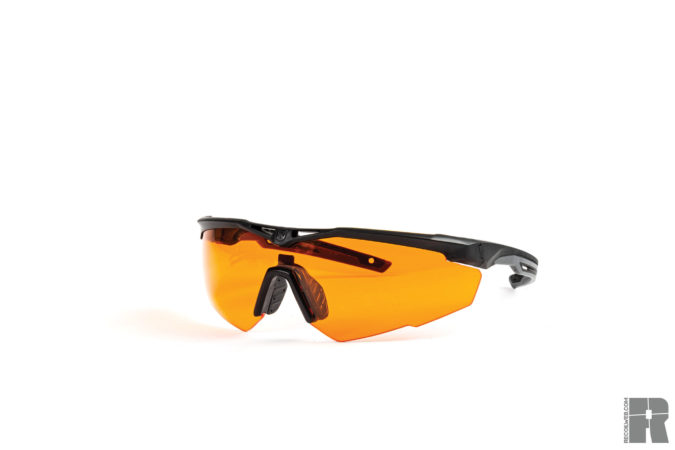
It’d be great if one lens blocked every color laser, but you’ll have to choose which wavelength (color) of laser you want protection from. Revision Military’s Stingerhawk laser and ballistic protective eyewear’s LazrBloc FT-2 lens (top) protects against violet, blue and green lasers (405nm OD4, 445nm OD4, 532nm OD4), while the LazrBloc GF-8 lens protects against green and near infrared (NIR) lasers (532nm OD2.5, 808nm OD2).
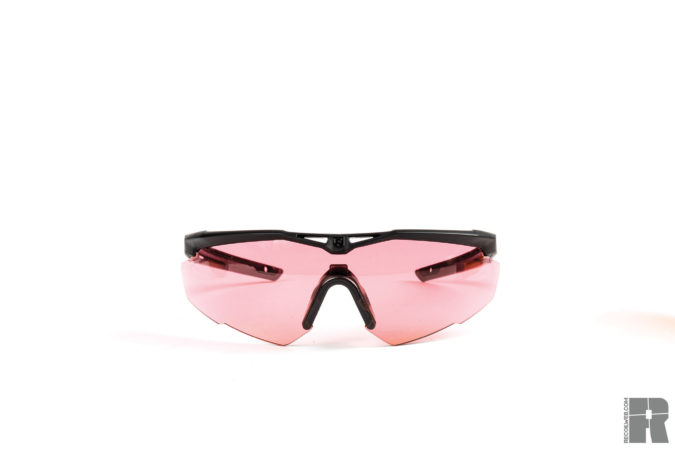
For nighttime use, you’ll want the highest VLT possible. That means maybe giving up protection from the less popular laser colors, such as blue, violet, and yellow, in favor of a lighter lens that provides greater situational awareness.
For line units working street protests, look for lenses that block green lasers for sure. Those are the most common. But be aware that green laser protective lenses won’t allow you to see the green laser projected reticle in your EOTech. Plan accordingly.
BOTTOM LINE
Current lens technology is evolving, but at the moment, the limitation of current laser lens technology means situational awareness and broad protection are on opposite sides of the coin. To see everything, you’ll have to give up some protection. Since lasers are still an emerging threat to law enforcement, the defensive technology is still in active development. Researchers are focused on finding a no-compromises solution to laser vision threats that’s practical for line units. We’re getting close but armed with the knowledge in this article, you should be clear on the hows and whys, as well as the compromises needed to make an informed decision when shopping for laser eyepro.
REVISION MILITARY Url: www.revisionmilitary.com

